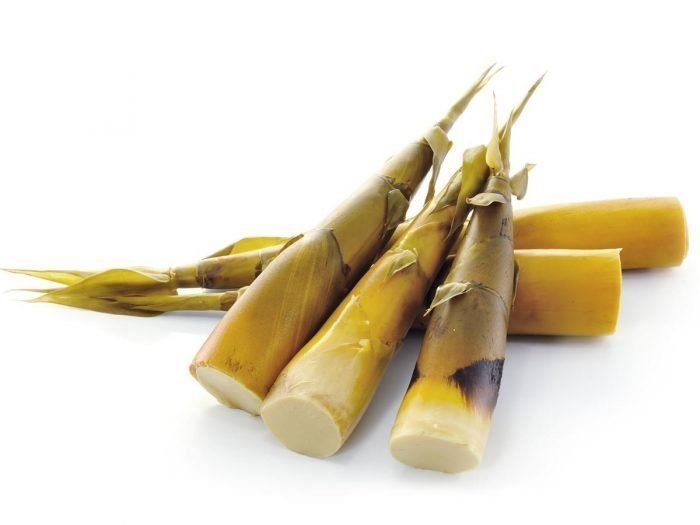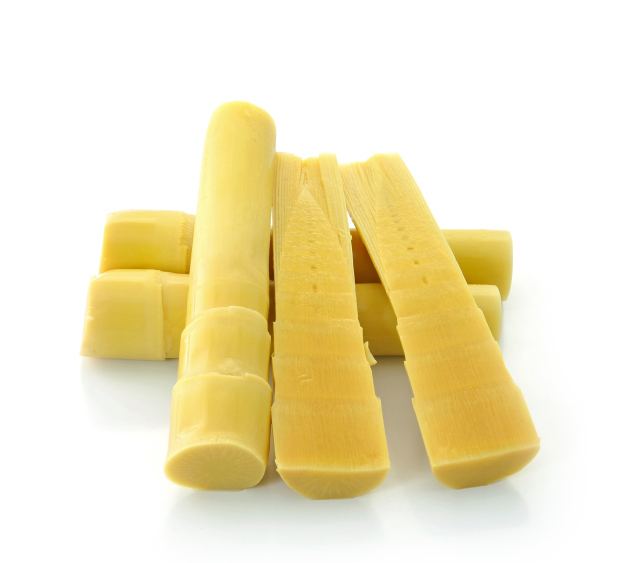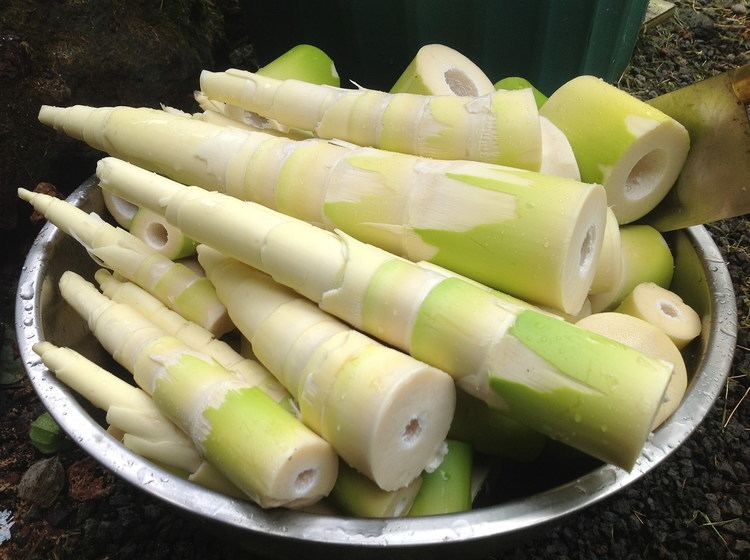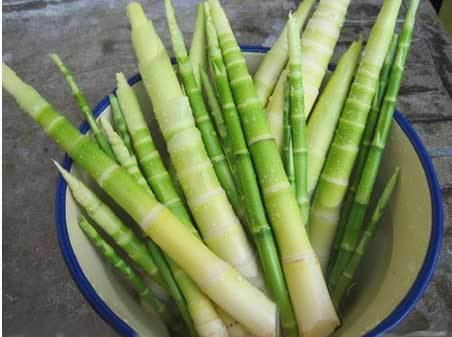Traditional Chinese 竹筍 Hanyu Pinyin Hangul 죽순, 대나무싹 | Simplified Chinese 竹笋 Jyutping zuk1 seon2 Revised Romanization juk sun, daenamu ssak | |
 | ||
Similar Shiitake, Menma, Water, Welsh onion, Tofu | ||
Digging up bamboo shoots
Bamboo shoots or bamboo sprouts are the edible shoots (new bamboo culms that come out of the ground) of many bamboo species including Bambusa vulgaris and Phyllostachys edulis. They are used in numerous Asian dishes and broths. They are sold in various processed shapes, and are available in fresh, dried, and canned versions.
Contents
- Digging up bamboo shoots
- Edible wild plants road trip collecting bamboo shoots in japan
- Harvested species
- Local names
- East Asia
- South Asia
- Southeast Asia
- References

Raw bamboo shoots contain cyanogenic glycosides, natural toxins also contained in cassava. The toxins must be destroyed by thorough cooking and for this reason fresh bamboo shoots are often boiled before being used in other ways. The toxins are also destroyed in the canning process.
Edible wild plants road trip collecting bamboo shoots in japan
Harvested species
Shoots of several species of bamboo are harvested for consumption:

Local names

Bamboo shoot tips are called zhú sǔn jiān (竹笋尖) or simply sǔn jiān (笋尖) in Chinese, although they are mostly referred to as just sǔn (笋). This sounds similar in Korean juk sun (죽순), a commonly used form, although the native word daenamu ssak (대나무싹) is present. In Vietnamese, bamboo shoots are called măng and in Japanese as take no ko (竹の子 or 筍). Chakma people from the Chittagong Hill Tracts of Bangladesh call it Bajchur and it is their traditional food. Bamboo shoot tips are called Myit in Myanmar. In Cambodia, they are called Tumpeang (ទំពាំង).
East Asia
In certain parts of Japan, China and Taiwan, shoots from the giant timber bamboo Bambusa oldhamii is harvested in spring or early summer. Young shoots from this species are highly sought after due to its crisp texture and sweet taste. Older shoots, however, have an acrid flavor and should be sliced thin and boiled in a large volume of water several times. The sliced bamboo is edible after boiling. B. oldhamii is more widely known as a noninvasive landscaping bamboo.
Pickled bamboo, used as a condiment, may also be made from the pith of the young shoots.
South Asia
In Nepal, they are used in dishes which have been well known in Nepal for centuries. A popular dish is tama (fermented bamboo shoot), with potato and beans. An old popular song in Nepali mentions tama as "my mother loves vegetable of recipe containing potato, beans, and tama". Some varieties of bamboo shoots commonly grown in the Sikkim Himalayas of India are Dendrocalamus hamiltonii, Dendrocalamus sikkimensis and Bambusa tulda locally known as choya bans, bhalu bans and karati bans, respectively are edible when young. These bamboo shoots are collected, defoliated and boiled in water with turmeric powder for 10–15 minutes to remove the bitter taste of the bamboo after which the tama is ready for consumption. Tama is commonly sold in the local markets during the months of June to September when young bamboo shoots sprout.
In Assam, India, bamboo shoots are part of the traditional cuisine. It is called khorisa and bah gaj in Assamese and "hen-up" among Karbi people in Assam
In Karnataka, India, the bamboo shoots are used as a special dish during the monsoons (due to seasonal availability) in Malnad region. It goes by the name kanile or 'kalale in the local language. It is usually sliced and soaked in water for two to three days, where the water is drained and replenished with fresh water each day to extricate and remove toxins. It is also used as a pickle. It is consumed as a delicacy by all communities in the region.
In the Diyun region of Arunachal Pradesh, the Chakma people call it bashchuri. The fermented version is called medukkeye, which is often served fried with pork. The bamboo shoots can also be fermented and stored with vinegar.
In Jharkhand, India, they are used in curries, and commonly used as a pickle.
In the western part of Odisha, India, They are known as Karadi and are used in traditional curries such as Ambila, pithou bhaja and pickle.
In Nagaland (India), bamboo shoots are both cooked and eaten as a fresh food item or fermented for a variety of culinary uses. Fermented bamboo shoot is commonly known as bas tenga. Cooking pork with a generous portion of fermented bamboo shoot is very popular in Naga cuisine.
In Manipur (India), it is known as u-soi. It is also fermented and preserved which is called soibum. It is used in a wide variety of dishes – among which are iromba, ooti and kangshu etc.
Southeast Asia
In Indonesia, they are sliced thinly to be boiled with coconut milk and spices to make gulai rebung. Other recipes using bamboo shoots are sayur lodeh (mixed vegetables in coconut milk) and lun pia (sometimes written lumpia: fried wrapped bamboo shoots with vegetables). The shoots of some species contain cyanide that must be leached or boiled out before they can be eaten safely. Slicing the bamboo shoots thinly assists in this leaching.
In Philippine cuisine, the shoots are commonly called labóng (others call it rabong or rabung). The two most popular dishes for this are ginataáng labóng (shoots in coconut milk and chilies) and dinengdeng na labóng (shoots in fish bagoóng and stew of string beans, saluyot, and tinapa). Bamboo shoots are also preserved as atchara, traditional sweet pickles that are often made from papaya.
In Thai cuisine bamboo shoots are called no mai. It can be used in stir-fries, soups such as tom kha kai, curries such as kaeng tai pla, as well as in Thai salads. Some dishes ask for fresh bamboo shoots, others for pickled bamboo shoots (no mai dong).
In Vietnamese cuisine, shredded bamboo shoots are used alone or with other vegetable in many stir-fried vegetable dishes. It may also be used as the sole vegetable ingredient in pork chop soup. Duck and bamboo shoot noodles (Bún măng vịt) is also a famous noodle dish in Vietnam.
In Chittagong Hill Tracts, Bangladesh, bamboo shoots are a traditional food of the indigenous Jumma people. The preparation of their dishes consist of several steps. At first bamboo shoots are collected from bamboo forest then defoliated and boiled in water. Afterwards the bamboo shoot is prepared with shrimp paste, chili, garlic paste, and salt.
In Burma (Myanmar), bamboo shoots are called myahait. They can be used in a soup called myahait hcaut tar la bot. The preparation of this dish generally follows three steps. At first the bamboo shoots are collected from a bamboo forest (called warr taw in Burmese). Bamboo can be found in the whole of Myanmar but the bamboo shoots from the two northernmost regions (Kachin State and Sagaing Region) are soft and good in taste. The bamboo shoots are then boiled in water after which they can be cooked with curry powder, rice powder etc. One of the most famous dishes in Burmese cuisine is a sour bamboo shoot curry called myahait hkyain hainn, a specialty of Naypyidaw in central Burma.
